I thought RANSAC is supposed to randomly select a subset of points to do the fitting, so why does it return the same transformation matrix every time?
RANSAC repeatedly selects a subset of points, then fits a model based upon them, then checks how many data points in the data set are inliers given that fitted model. Once it's done that lots of times, it picks the fitted model that had the most inliers, and refits the model to those inliers.
For any given data set, set of variable model parameters, and rule for what constitutes an inlier, there will exist one or more (but often exactly one) largest possible set of "inliers". For example, given this data set (image from Wikipedia):

... then with some sort of reasonable definition of an outlier, the maximal possible set of inliers any linear model can have is the one in blue below:

Let's call the set of blue points above - the maximal possible set of inliers - I.
If you randomly select a small number of points (e.g. two or three) and draw a line of best fit through them, it's hopefully intuitively obvious that it'll only take you a handful of tries until you hit an iteration where:
- all the randomly-selected points you pick are from I, and so
- the line of best fit through those points is roughly equal to the line of best fit in the graph above, and so
- the set of inliers found on that iteration is exactly I
From that iteration onwards, all further iterations are a waste that cannot possibly improve the model further (although RANSAC has no way of knowing this, since it doesn't magically know when it's found the maximal set of inliers).
If you have a large enough number of iterations relative to the size of your data set, and a large enough proportion of the data set are inliers, then you will eventually find the maximal set of inliers with a close to 100% chance every time you run RANSAC. As a consequence, RANSAC will (almost) always output exactly the same model.
And that's a good thing! Often, you want RANSAC to find the absolute maximal set of inliers and don't want to settle for anything less. If you're getting different results each time you run RANSAC in such a scenario, that's a sign that you want to increase your number of iterations.
(Of course, in the case above we're talking about trying to fit a line through points in a 2D plane, which isn't what findHomography does, but the principle is the same; there will typically still be a single maximal set of inliers and eventually RANSAC will find it.)
How can I make this behaviour actually random?
Decrease the number of iterations (maxIters) so that RANSAC sometimes fails to find the maximal set of inliers.
But there's generally no reason to do this besides pure intellectual curiosity; you'll basically be deliberately telling RANSAC to output an inferior model.

